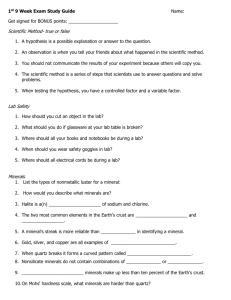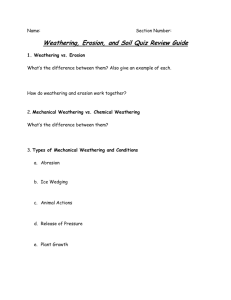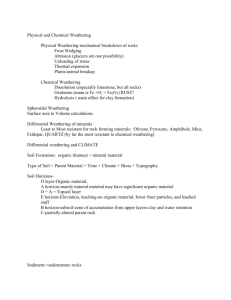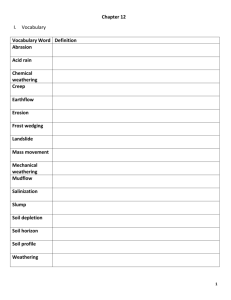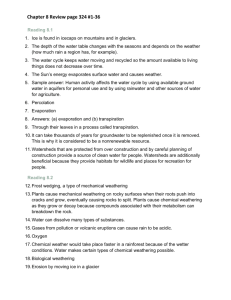Soils & weathering
advertisement
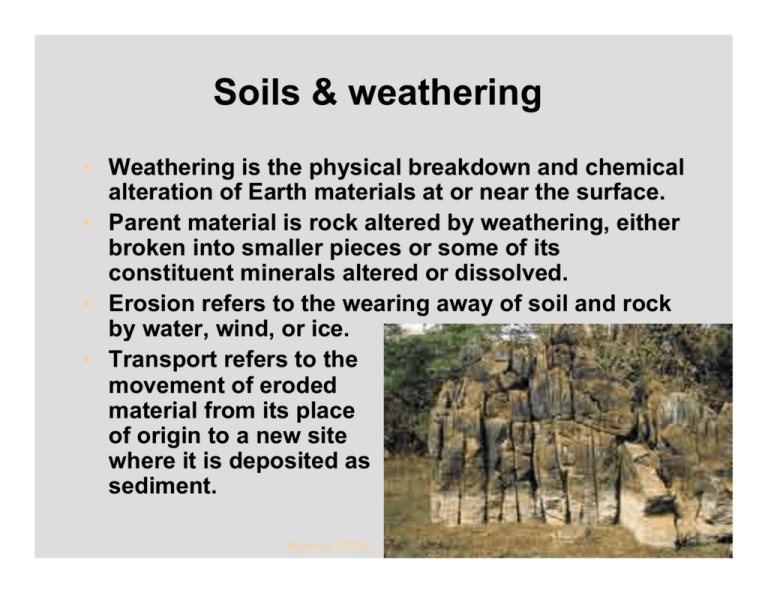
Soils & weathering • Weathering is the physical breakdown and chemical alteration of Earth materials at or near the surface. • Parent material is rock altered by weathering, either broken into smaller pieces or some of its constituent minerals altered or dissolved. • Erosion refers to the wearing away of soil and rock by water, wind, or ice. • Transport refers to the movement of eroded material from its place of origin to a new site where it is deposited as sediment. Marshak (2003) Why Study Weathering, Erosion & Soils • Weathering, erosion, and soil are good examples of the continuous interactions of the atmosphere, hydrosphere, and biosphere with Earth materials. • Weathering, an essential part of the rock cycle, plays an important role in the formation of sediments, the raw materials for sedimentary rocks. • Weathering forms soils on which we depend for food production and is important for formation of some mineral resources. • Erosion degrades soils and eroded sediments degrade rivers and streams. Wicander and Monroe (2002) Arches Nal’t Park, Utah Introduction • Two types of weathering are recognized: mechanical and chemical. Both proceed at the same time, but at a given site one type will be predominant. • In their resistance to weathering, rocks are not homogeneous. One may weather faster or slower than another. Parts of the same rock may weather at different rates. This process, known as differential weathering, creates many picturesque and bizarre features, such as arches and honeycomb weathering. Pebble Beach, Calif. Wicander and Monroe (2002) Weathering • Mechanical weathering – physical breakdown of rocks without changing the composition (freeze thaw) • Chemical weathering – breakdown of minerals by chemical reactions with air or water Source: Photograph courtesy of USDA Soil Conservation Service. Montgomery (2003) Mechanical Weathering Mechanical weathering occurs when physical forces break Earth materials into smaller pieces. The granite shown here, for instance, has mechanically weathered to produce smaller pieces of granite and individual grains of the minerals comprising the granite, quartz and feldspars. Wicander and Monroe (2002) Frost Action Frost action involves the repeated freeze and thaw of water in the cracks and pores of rocks. This results in frost wedging, a very effective process for widening and extending cracks and thereby breaking rocks into smaller pieces. When water freezes, it expands in volume by 9% which exerts great force on the walls of containing cracks and pores. Wicander and Monroe (2002) Pressure Release In deep, underground mines such as some of the diamond mines of South Africa, rock sometimes expands violently in response to the pressure released by removal of the mine rock. These rock bursts kill 20 miners/year. Excavations of only 7 or 8 m in the granite quarries have produced sheet joints with enough force to knock the tracks off of the heavy quarrying equipment. North Carolina Wicander and Monroe (2002) Chemical Weathering • Chemical weathering refers to the processes that decompose rocks and minerals. • In some instances, minerals are chemically altered such that new minerals are formed. • Other minerals may completely dissolve and their ions taken into solution. Chernicoff & Whitney (2002) Chemical weathering • Important agents of chemical weathering include atmospheric gases, especially oxygen, water, and organic acids produced by plants and decaying organic matter. Marshak (2003) Chemical Weathering - Solution Solution is a type of chemical weathering reaction wherein interaction of a solid with a liquid separates the ions of the solid such they come to reside in the liquid and the solid is thus dissolved. Water can easily dissolve some minerals because the water molecule has an asymmetric shape. The two hydrogen atoms are not evenly spaced around the oxygen atom to which they are bonded. The side of the water molecule where the hydrogen atoms are located has a slight positive charge and the other side a slight negative charge. _ + Wicander and Monroe (2002) Chemical Weathering - Solution When soluble minerals such as halite (NaCl) come in contact with water, the positively charged sodium ions are attracted to the negative end of the water molecules, and negatively charged chloride ions are attracted to the positive end of the water molecules . In this way the ions are pulled from the structure of the mineral, surrounded by water molecules, and the solid dissolved. Wicander and Monroe (2002) Chemical Weathering - Solution • Most minerals are not easily dissolved in pure water. Calcite (CaCO3), the mineral in limestone and marble, does not dissolve in pure water, but easily dissolves if a small amount of acid is added to water. Atmospheric carbon dioxide, or that produced by decay of organic matter, reacts with water to form carbonic acid. The acidified water can then dissolve calcite as is shown in the following chemical reaction. CaCO3 + H2O + calcite CO2 Ca2+ + 2HCO3- water carbon calcium bicarbonate ion dioxide ion • Solution chemical weathering forms extensive cave systems in limestone and marble, such as Mammoth Cave and Carlsbad Caverns. Chemical Weathering - Oxidation • Oxidation is a chemical weathering reaction whereby metal elements like iron combine with oxygen to form oxides. Oxidation is important for the weathering of ferromagnesian minerals such as olivine, amphibole, and biotite. When the iron in these minerals oxidizes hematite is commonly formed by the following chemical reaction. 4Fe + O2 iron oxygen 2Fe2O3 hematite • The acid mine drainage so common in coal mining areas is produced by oxidation of pyrite (FeS2 ), a mineral common in coal and associated rocks. The resulting iron oxide minerals form a reddish or yellowish sludge, while the sulfuric acid produced acidifies the drainage water. Chemical Weathering -Hydrolysis • In the chemical weathering reaction known as hydrolysis, hydrogen ions (H+) contained in water replace positive ions in a mineral. As a result, a new mineral forms and the replaced ions are dissolved in the water. In this way clay minerals, which are sheet silicates, are formed from framework silicates such as feldspars. 2KAlSi3O8 + 2H+ + 9H2O orthoclase hydrogen water ion Al2Si2O5(OH)4 + 2K+ + 4SiO2 clay mineral (kaolinite) potassium silica ion ion How Fast is Chemical Weathering? • Chemical weathering proceeds from the surface of a rock inward. As a result, when a weathered rock is broken open, an outer weathered rind and relatively unweathered interior are commonly present. • The rate of chemical weathering is controlled largely by climate, particle size, and mineralogy of the parent material rock. • Water enters rocks along fractures, so the more fractures, the more opportunities for chemical weathering. Wicander and Monroe (2002) Weathering • In general biological and chemical processes dominate weathering. Mechanical processes only dominate in areas where climate restricts these two processes. • Whereas mechanical weathering has little effect on soil composition chemical weathering will tend to deplete elements from the soil Montgomery (2003) Particle Size Rate of Weathering • • Chemical weathering affects particle surfaces, and the greater the surface area, the more effective is weathering. Smaller particles have greater surface areas compared to their volumes than do larger particles. As mechanical weathering splits a block into smaller pieces, total volume is unchanged, but total surface area increases as does susceptibility to chemical weathering. Wicander and Monroe (2002) Climate & weathering • Chemical weathering reactions require the presence of water. In general, chemical reactions proceed more rapidly at higher temperatures. • Chemical weathering is most intense in tropical climates where both rainfall and temperature are high. In areas of tropical climate, the effects of chemical weathering extend to depths of several tens of meters. Chernicoff & Whitney (2002) Climate & weathering • Where temperature is low and/or liquid water scarce, such as in arctic or arid regions, the intensity of chemical weathering is much reduced and the depth to which it reaches is only centimeters, or at best a few meters. Chernicoff & Whitney (2002) Climate and soil type Pipkin and Trent (1997) Importance of Parent Material Some rocks are more resistant to chemical weathering than others because different minerals weather at different rates. The chemical stability of common minerals is the opposite of their order of crystallization from molten material Relative Stability of Silicate Minerals Ferromagnesian Silicates Olivine Pyroxene Amphibole Biotite Non-Ferromagnesian Silicates Calcium Plagioclase Sodium Plagioclase Potassium Feldspar Muscovite Quartz How does soil form? • Regolith collectively refers to sediment of all types, as well as residual products of weathering formed in place. Regolith covers most of Earth’s land surface. • Soil is a type of regolith. Soil supports plant growth and consists of: 1) weathered material, mostly sand, silt, and clay, 2) pore spaces filled with air and/or water, and 3) variable amounts of organic matter known as humus. • Humus is carbon derived from organic matter by bacterial decay and is highly resistant to further decay. • Residual soils form by weathering of rock in place. • Transported soils develop by weathering of sediment. Residual soils • In temperate climates granite decomposes into soils containing quartz, weathered feldspar and clays • Engineers and geologists call slightly weathered granite decomposed granite • This makes and excellent foundation material for roads and structures Transported soils • These are classified based on the agent that has transported them • Alluvial - transported by rivers • Eolian - transported by wind • Glacial - transported by glacier • Pleistocene glaciers scraped off Canada’s soils and redeposited them in the US Transported soils • Loess are wind-blown silt deposits that cover ~20% of the US and 10% of the Earth • It is possibly the Earth’s most fertile soil (Hitler moved large quantities of the Ukraines’s loess to Germany) • Derived from glacial deposits and deserts Factors Influencing Soil Formation • • • • • • • • • Earthworms Burrowing animals Plant roots Bacteria and Fungi (decomposers) Position on slope Climate Time Rainfall Soil pH Soil Formation • Climate is the most important factor in soil formation because of its strong influence on chemical weathering. Parent material, relief and slope, organisms, and time are other factors. • Pedalfers, soils with organic-rich A horizons and Al- and Fe-enriched B horizons, form in the humid, temperate eastern U.S. • Pedocals, soils with organic-poor A horizons and calcite enriched-B horizons, form in the semiarid western U.S. • Laterites support lush vegetation and form in the tropics. They are thick, highly weathered soils rich in insoluble aluminum hydroxides, iron-oxides, and clay minerals. Climate and Soil Wicander and Monroe (2002) Climate affects soil type, thickness, and fertility laterites pedocals pedalfers tundra soils Soil type Marshak (2003) Relief and Slope • Relief is the difference in elevation between the high and low points of an area. Climate varies with elevation such that soils differ from mountains to adjacent lowlands. Slope affects soil formation in two ways. Slope angle effects soil removal by erosion. Slope direction controls controls the amount of sunlight a soil receives. Northfacing slopes receive less sunlight and are cooler, wetter, and support different vegetation than southfacing slopes. Wicander and Monroe (2002) Effect of landscape Chernicoff & Whitney (2002) Time • The rate of soil formation varies extensively from site-to-site because it is dependent on the other soil- forming factors. Nonetheless, an overall average of about 2.5 cm/100 years is often quoted. • All other factors being the same, soil will develop more rapidly on sediment than on bedrock because of the greater internal surface area of the sediment. • Soil formation operates rapidly in the context of geologic time, but is a slow process from the human perspective. • From the human perspective, soil is a nonrenewable resource. Soils • Humus - Decaying organic material. • Humus becomes mixed with the top layers of rock particles, and supplies some of the needed nutrients to plants. • Humus also creates crumbly soil which allows adequate water absorption and drainage. The Soil Profile • A soil profile is a vertical cross section of a soil. Soil horizons are distinct layers that differ from one another in color texture, structure, and composition. Wicander and Monroe (2002) Soil Horizons • O Horizon - (Litter) Undecomposed or partially decomposed organic material. • A Horizon - (Topsoil) Uppermost layer - contains most of the soil nutrients and organic matter. • E Horizon - Formed from leaching darker materials. • Not formed in all soils. • Usually very nutrient poor. Enger and Smith (2002) Soil Horizons • B Horizon - (Subsoil) Underneath topsoil. Contains less organic matter and fewer organisms, but accumulates nutrients leached from topsoil. Poorly developed in dry areas. • C Horizon - Weathered parent material - very little organic material. • R Horizon - Bedrock Enger and Smith (2002) Soil types Enger and Smith (2002) Describing soils • Colour • Soil colour is generally a reflection of its composition • High organic matter = black or brown • High Fe imparts a red or yellow colour Montgomery (2003) Describing soils- texture • This is related to the size of the fragments in the soil • Sand (2 - 0.05 mm) • Silt (0.05 - 0.002 mm) • Clay (<0.002 mm) • Sandy soils will drain more quickly than clay soils • Too many large particles leads to extreme leaching. • Too many small particles leads to poor drainage. Montgomery (2000) Worldwide Major Soil Types Soil classification Figure 11.8 Modern classifications are more complex with 100’s or 1000’s of subdivisions Source: Map from World Soil Resources Office of U.N. Natural Resources Conservation Service. Montgomery (2003)



